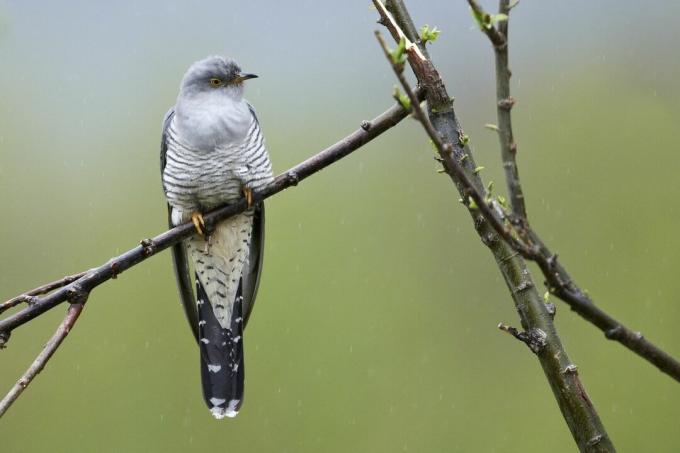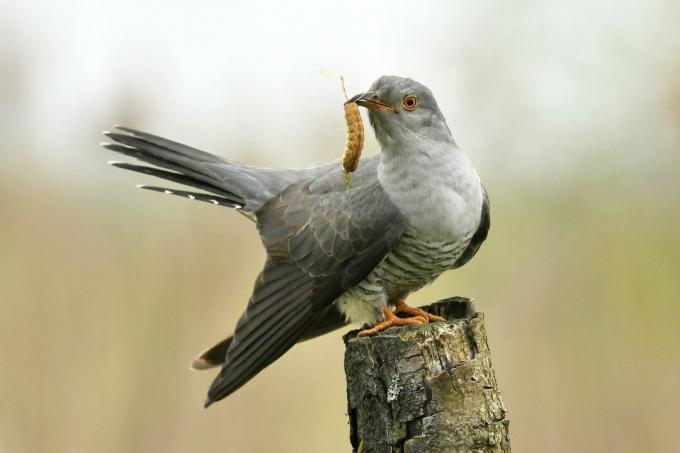Why does the cuckoo lay its eggs in other birds' nests? Does the cuckoo build a nest by itself too? And when should you report a cuckoo when you see or hear it? Everything about the well-known native bird in our species portrait.

The Cuckoo (Cuculus canorus) is a well-known bird. Its eponymous reputation and its tendency to lay eggs in other birds' nests are qualities that nobody will soon forget. But what else do you know about the cuckoo? Have you actually seen the magnificent bird once and would you have recognized it in the picture above? In order to give the cuckoo a better image than that of a parasite, we would like to use the illuminate different facets of his life and answer any questions you may have about the bird of the year 2008 respond.
"Contents"
- Cuckoo: Wanted poster
-
This is how you recognize the cuckoo
- How does the cuckoo call sound?
- How do female and male cuckoos differ?
- How do you recognize a young cuckoo bird?
- Which habitat does the cuckoo prefer?
- What do cuckoo eggs look like?
- When is the cuckoo's breeding season?
- Where does the cuckoo spend the winter?
-
Support the cuckoo in the garden: this is how it works
- What do cuckoos eat?
- How can you support cuckoos in addition?
Cuckoo: Wanted poster
| size | 32 - 36 cm |
| weight | 100-140 g |
| Breeding season | Depending on the host bird species |
| lifespan | Up to 10 years |
| habitat | Light forests and structured cultural landscapes |
| food | Insects, spiders, worms and other small animals |
| Threats | Decrease in food and habitat loss |
This is how you recognize the cuckoo
The cuckoo is about the size of a pigeon, but slimmer and characterized by a long, black-and-white patterned tail. Its upper side is gray to brown in color and its light, white belly is traversed by fine, dark transverse bands that are reminiscent of a sparrowhawk. Noticeable splashes of color are also his yellow-rimmed eyes and feet of the same color.

How does the cuckoo call sound?
The call of the cuckoo consists of a two-syllable, loud "Ku-kuh", which is stressed on the first syllable and gives the cuckoo its name. And in fact, this is not only true in German: in other countries, too, the bird is named after its typical utterance. For example, the cuckoo is called “cuckoo” in English or “koekoek” in Dutch.
The call of the cuckoo sounds like this:

How do female and male cuckoos differ?
While a male cuckoo has mainly gray plumage and a monochrome head and chest female cuckoos come in two different color variants, also known as "morphs" will. The first color morph is gray and looks quite similar to the male. The only difference is the slightly brownish tinge of the chest, which is criss-crossed with a similar transverse banding as the belly. The second, rarer morph, however, shines in a rust-brown plumage, which is criss-crossed by strong, dark ribbons.

How do you recognize a young cuckoo bird?
Young cuckoos are even more conspicuously patterned than their parents. Their entire plumage is criss-crossed by strong, dark transverse bands. The back and wing covers of the young animals are also covered with brown spots and a noticeable white spot can be seen on the neck of the young animals.

Which habitat does the cuckoo prefer?
The cuckoo has a broad habitat. It occurs in sparse forests, but also in cultivated landscapes that have structures such as hedges or other high vegetation. Only very dense forests are avoided. And of course the occurrence of the cuckoo depends on the distribution of its host bird species.
What do cuckoo eggs look like?
This question is not that easy to answer. Because female cuckoos can match their eggs in color to those of the host species in order to camouflage them in the foreign clutch. Different females have different preferences as to which bird species they parasitize, and they pass on their adaptation to that bird species to their daughters. You can still recognize a cuckoo's egg by its size, because it is usually always slightly larger than the host's eggs. The cuckoo never builds its own nest, but only uses that of other bird species. Female cuckoos lay around ten eggs a year, each of which is placed in a different, strange nest.

When is the cuckoo's breeding season?
Since the cuckoo does not hatch its eggs itself, it basically has no breeding season of its own. The time of oviposition depends on the oviposition of the host bird species and occurs shortly after or even during it. Due to its short breeding season of around twelve days, the cuckoo child usually hatches before the offspring of the host bird. This allows him to clear the other eggs from the nest before they hatch so that the strange baby birds cannot compete for food. Because of its size, the cuckoo cub needs all the food that the parent birds carry into the nest for itself.

Note: As dramatic as the cuckoo's behavior sounds, it has no negative impact on the host bird populations. Even in species that are relatively often parasitized by the cuckoo, the proportion of “captured” nests is less than one percent. However, the cuckoo itself has given itself a decisive advantage with its behavior, because it saves itself a lot of work. The energy gained in this way can then be invested in long journeys, for example.
Where does the cuckoo spend the winter?
The cuckoo is a Migratory birdwho spends his winters in the tropical savannahs of Africa. He is a long-distance migrant who leaves his breeding area early in the year and only comes back relatively late. German cuckoos, for example, move south as early as August and will not be our guests again until the end of May.
Support the cuckoo in the garden: this is how it works
Due to the monotonization of the landscape and the increasing loss of insects and other small animals The cuckoo has been deprived of its livelihood piece by piece and the population has been going strong for several years return. Find out how you can support the magnificent bird here.
What do cuckoos eat?
Cuckoos feed exclusively on animal food. They hunt insects, spiders, worms and other small animals. Sometimes even small frogs and other amphibians are eaten. Vegetable food, on the other hand, is not on the cuckoo's menu. That's why you can't lure him with classic birdseed.

If you still want to support the cuckoo in your own garden, you can design one insect-friendly garden move a lot though. For example, by creating a flower meadow, you can create a wonderful living space for numerous Create insects and other small garden dwellers on which many garden birds and also the cuckoo do kindly can. You can do this quickly and easily with our, for example Plantura beneficial insect magnetwhich conjures up a paradise of native wildflowers for you in no time at all, which will bring life to your garden from May to September.
How can you support cuckoos in addition?
It is not just the lack of food and living space that troubles the cuckoo. Climate change could also soon have a very negative impact on populations. As spring begins earlier and earlier, the start of breeding for many bird species is also shifting forward. However, since the cuckoo has to cover a long distance from its winter quarters, it may soon arrive too late and miss the start of breeding for its host birds. A lot of research is currently being carried out on this topic.
Another species of bird that has made a name for itself mainly through its characteristic song is the Chiffchaff. Get to know this garden bird a little better in our detailed species portrait.
